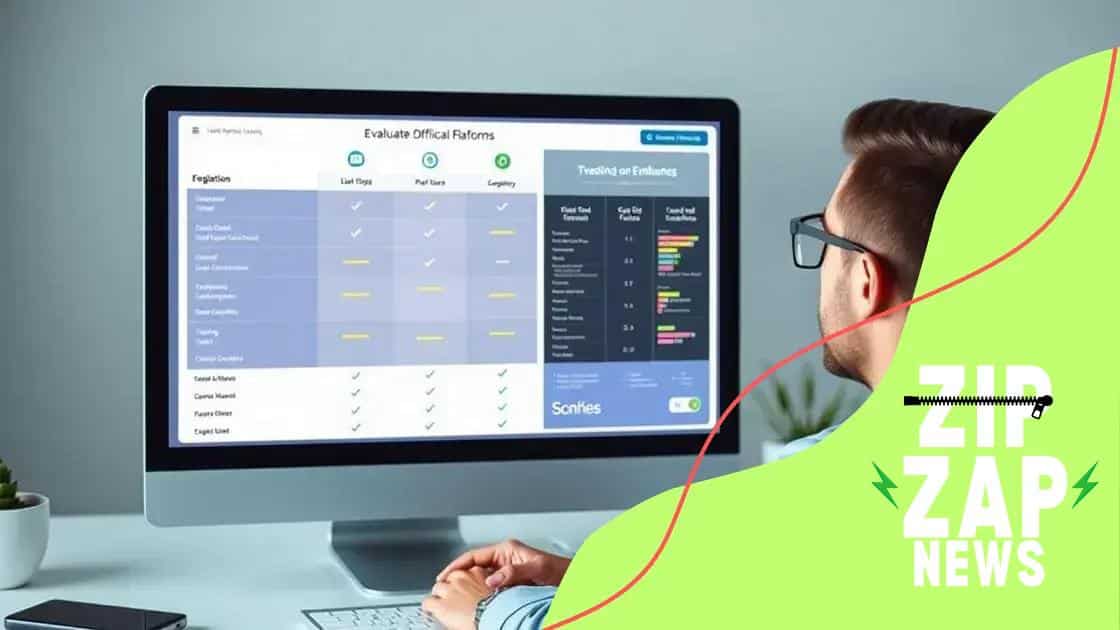Streamlining benefits enrollment with digital tools

Streamlining benefits enrollment with digital tools enhances efficiency, improves employee engagement, minimizes errors, and provides essential data security while meeting modern workplace demands.
Streamlining benefits enrollment with digital tools can transform the way organizations manage employee benefits. Have you ever wondered how technology could simplify this often cumbersome process? Let’s dive in!
Understanding the digital enrollment process
Understanding the digital enrollment process is crucial for both employees and employers. With advancements in technology, the way benefits are enrolled has changed significantly, making it more accessible and streamlined.
Let’s explore how this process works and what makes it effective.
Key Steps in the Digital Enrollment Process
The digital enrollment process involves a series of important steps. Each step is designed to ensure that the experience is smooth for everyone involved. Here are the main components of the process:
- Account Creation: Employees create an online account that securely stores their personal information.
- Information Input: Users enter necessary data such as dependents and selecting benefit options.
- Review Options: Employees can review various benefits tailored to their needs, including health insurance and retirement plans.
Following the key steps ensures that all information is correctly submitted and reduces errors.
Advantages of Digital Enrollment
Using digital tools for enrollment has many advantages. Not only does it save time, but it also simplifies the entire process.
Some benefits include:
- Efficiency: Digital platforms speed up the enrollment process, allowing users to complete everything quickly.
- Accessibility: Employees can enroll from anywhere, at any time, using a computer or mobile device.
- Reduced Paperwork: Digital tools minimize the need for physical forms, which is better for the environment and easier to manage.
Understanding these aspects helps employees navigate their choices and makes the enrollment experience better.
As we look deeper into how digital tools improve the enrollment process, it’s clear that innovation plays a pivotal role in enhancing user experience. This new approach not only caters to individual needs but also aligns with modern workplace expectations.
Digital enrollment represents a shift toward a more user-friendly interaction. By simplifying the steps and providing immediate access to important information, organizations can ensure that employees feel confident in their benefits choices.
Key benefits of digital tools for enrollment
The key benefits of digital tools for enrollment truly enhance the experience for both employees and companies. By utilizing modern technology, organizations can streamline their processes and provide valuable support.
First, let’s consider how adopting digital tools can change the game.
Efficiency and Speed
Digital enrollment reduces the time it takes to complete benefits registration. Employees can access information quickly and make selections without delays. This rapid process increases overall productivity for the organization as well.
Beyond efficiency, these tools offer other significant advantages.
Improved Accessibility
With digital platforms, employees can enroll from any location. This means individuals can manage their benefits on their schedules, leading to greater satisfaction and less stress.
- Remote Access: Employees can enroll using their smartphones or computers.
- 24/7 Availability: The enrollment portal is open at all hours, allowing for flexibility.
- Easy Updates: Changes to personal information can be made instantly.
Additionally, digital tools promote better engagement. Employees feel more involved in the process, leading to informed decision-making. Access to detailed information helps individuals understand their options, which can lead to selecting the right benefits for themselves and their families.
Reduction of Errors
Another benefit of using digital enrollment tools is minimizing human errors. When data is entered electronically, the risk of mistakes decreases significantly compared to paper forms. This accuracy ensures that employees receive the correct benefits and prevents issues during claims.
In summary, the transition to digital tools for enrollment offers a range of advantages. Increased efficiency, better accessibility, and reduced errors represent significant steps toward optimizing the benefits enrollment experience.
How to choose the right digital platform

Choosing the right digital platform for benefits enrollment can seem overwhelming, but taking the right steps makes it manageable. A good platform can significantly impact the employee experience and streamline the process for employers.
Let’s look at some important factors to consider when making this decision.
Assess Your Needs
The first step is understanding your organization’s specific needs. Consider the size of your team and the type of benefits you want to offer. Different platforms cater to different needs, so aligning your requirements is crucial.
- Employee Size: Choose a platform that can accommodate your workforce.
- Benefit Options: Ensure it can handle various types of benefits like health, retirement, and wellness programs.
- Budget Considerations: Factor in costs associated with implementation and maintenance.
Once you’ve assessed your needs, it’s time to explore the platforms available.
Evaluate Features
Different digital platforms offer various features that can enhance the enrollment experience. When evaluating options, look for platforms that provide:
- User-Friendly Interface: An intuitive design makes it easy for employees to navigate.
- Mobile Accessibility: Ensure the platform is accessible from smartphones and tablets.
- Integration Capabilities: The platform should work well with other HR systems already in place.
Additionally, read reviews and case studies to understand how other organizations have benefited from specific platforms. This research can provide insights into their performance and reliability.
Think About Support
Having responsive customer support is vital when choosing a digital platform. You need to ensure that help is available whenever you encounter issues. A strong support team can help you get the most out of the platform and address any challenges swiftly.
Transparency regarding fees and contract terms is also critical. Look for platforms that provide clear information about pricing and any potential hidden costs.
Best practices for implementing digital enrollment
Implementing digital enrollment effectively can transform the employee experience significantly. To ensure a smooth transition, following best practices is essential. These guidelines help organizations maximize benefits and minimize complications.
First, it is vital to plan your implementation strategy carefully.
Define Clear Objectives
Set clear goals before launching the digital enrollment process. Know what you want to achieve, whether it’s improving efficiency, enhancing user experience, or reducing paperwork. Make sure your objectives align with overall business goals to create a positive impact.
Engage Stakeholders
Involve key stakeholders early in the process. This includes HR, IT, and employees who will use the platform. Gaining their insights can help you understand needs and expectations, making the implementation smoother. Regularly communicate updates and involve them in testing to gather feedback.
Provide Comprehensive Training
Training is crucial for success. Ensure that employees are well-acquainted with the new digital tools. Offer tutorials, guides, and live demonstrations to help them navigate. This preparation fosters confidence and encourages participation.
- Online Workshops: Conduct virtual sessions to reach remote employees.
- Resource Materials: Create easy-to-understand manuals and FAQs.
- Ongoing Support: Offer help desks or chat support during the initial rollout.
After training, actively collect feedback during the rollout phase. Make adjustments based on user experiences to enhance the platform continually. Listening to employees ensures that their needs are met.
Monitor Performance
Finally, monitor the effectiveness of your digital enrollment program. Use key performance indicators (KPIs) to measure success. Look at enrollment rates, user satisfaction, and time taken to complete enrollment. Regular assessments help identify areas for improvement and ensure long-term success.
Common challenges and solutions in digital enrollment
Implementing digital enrollment can bring many benefits, but it also comes with challenges. Identifying these issues early on can help organizations develop effective solutions.
Let’s explore some common challenges and how to address them effectively.
Employee Engagement
One major challenge is ensuring employee engagement in the digital enrollment process. Employees may feel overwhelmed by new technology or unsure about the steps to take. This can lead to incomplete enrollments or dissatisfaction.
- Solution: Provide clear instructions and resources. Online tutorials or workshops can help employees feel more confident in using the platform.
- Solution: Encourage questions. Let employees know that it’s okay to ask for help if they are unsure.
- Solution: Highlight benefits. Show how the digital platform makes enrolling easier and more convenient.
Technical Issues
Technical difficulties often arise during digital enrollment. These might include software glitches, slow loading times, or issues with user accounts. Such problems can frustrate users and hinder the enrollment process.
To combat these issues, monitored support is necessary. Create a responsive support team that can address technical problems promptly. Having a dedicated helpdesk ready to assist employees can significantly reduce downtime.
Data Security Concerns
With online platforms, data security is always a concern. Employees want to know that their personal information is safe. Fear of breaches can lead to hesitance in using digital enrollment systems.
Organizations can address this by investing in robust security measures. Regular updates and audits of security protocols will help reassure employees. Providing transparency about how data is protected builds trust.
Integration with Existing Systems
Another challenge is ensuring that the digital enrollment platform integrates well with existing HR software. Lack of compatibility can create headaches regarding data transfer and management.
- Solution: Choose platforms designed for easy integrations.
- Solution: Consult with IT professionals during the selection process.
- Solution: Test the platform with existing systems before implementation to smooth out any issues.
By recognizing these common challenges and proactively seeking solutions, organizations can create a positive experience for employees during digital enrollment.
In conclusion, implementing digital enrollment can greatly enhance the employee benefits experience. By understanding common challenges and applying effective solutions, organizations can create a smoother transition. Engaging employees, addressing technical concerns, ensuring data security, and facilitating integration are key factors for success. With the right approach, digital enrollment can lead to greater efficiency and satisfaction for everyone involved.
FAQ – Common Questions About Digital Enrollment
What is digital enrollment?
Digital enrollment is the process of using online platforms to register employees for benefits, making it easier and faster.
How can I improve employee engagement during digital enrollment?
Providing clear instructions, training sessions, and highlighting the benefits of the digital platform can enhance employee involvement.
What should I do if employees face technical issues during enrollment?
Ensure a responsive tech support team is available to address any problems quickly, assisting employees as needed.
How do I ensure data security during online enrollment?
Invest in strong security measures, including encryption and regular audits, to protect employee information from breaches.





